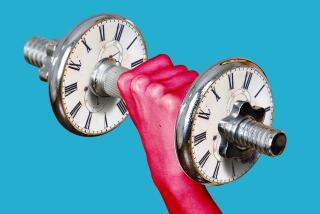Resistance training that you can try at home
How much strength training is enough to build muscles and garner some health benefits? Kent Adams, director of the exercise physiology lab at Cal State Monterey Bay, says most healthy people can follow the basic guidelines from the American College of Sports Medicine, which recommends doing eight to 12 repetitions of eight to 10 strength-training exercises twice a week. (That’s in addition to doing moderately intense cardio workouts for 30 minutes a day, five days a week.)
But how can you tell whether you’re using enough weight to build muscle? If you can lift a weight easily 10 to 12 times without breaking a sweat, it’s too light. The muscles need to be challenged, so by the end of a set of 10 repetitions, the weight should be extremely challenging to push or pull. This also goes for body-resistance exercises, such as push-ups or abdominal crunches.
For those who have never used weights before, investing in a few sessions with a personal trainer is a good idea. A certified trainer can not only tell you what exercises to do, but can show you how to do them correctly to avoid injury.
Want to get started with resistance training? Quincy Burgers, assistant personal training manager for Crunch Fitness in Los Angeles, suggests a few simple exercises that can be done at home:
Squats: Start with feet shoulder-width apart and hands in the air, maintaining a straight line from the fingers to the shoulders to the spine. Slowly drop into a squat, bending the knees as if about to sit in a chair. Go back to a standing position and repeat. If you feel pain in your back, that means core muscles (the ones surrounding the trunk, including the back) are not being activated. This exercise targets the quadriceps, hamstrings, glutes, calves and core muscles. Keeping the arms up also activates muscles in the shoulders and back.
Push-ups: Start in a plank position close to the ground with the body elevated by the feet and hands, palms on the ground a little wider than the shoulders. The body should be stable and the abdominal muscles engaged. Push the body up with the arms, making sure core muscles are activated — if they’re not, too much strain will be placed on the back. Lower back down to the ground and repeat about 15 times, or as many as possible. This exercise can be modified by holding the body up with the knees instead of the feet, but make sure there’s padding underneath, such as a yoga mat or towel. This exercise targets chest, core and shoulder muscles and triceps.
Lunge: Stand with feet shoulder-width apart, hands on hips. Take a step forward, creating a 90-degree angle with the front knee, making sure the knee does not extend past the toes. The back leg also bends, with the weight on the ball of the foot and the heel up and off the floor. Keep the back, neck and head straight and aligned. Push off with the front foot back to a standing position. Repeat with the other foot. Do three sets of 10 repetitions on each side. This activates the hamstrings, quadriceps, glutes, calves and core muscles.
—Jeannine Stein






